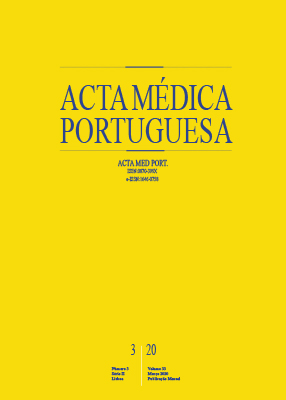Risco de Apneia Obstrutiva do Sono Não Diagnosticada em Indivíduos Obesos no Contexto dos Cuidados de Saúde Primários
DOI:
https://doi.org/10.20344/amp.12319Palavras-chave:
Apneia Obstrutiva do Sono/diagnóstico, Cuidados de Saúde Primários, Inquéritos e Questionários, Obesidade, PortugalResumo
Introdução: A apneia obstrutiva do sono é uma entidade clínica que condiciona aumento da morbimortalidade e estima-se que exista um elevado subdiagnóstico. Foi objetivo deste estudo avaliar o risco de apneia obstrutiva do sono não diagnosticada em indivíduos obesos.
Material e Métodos: Estudo transversal descritivo e analítico; durante um período de 11 meses foi avaliado o risco de apneia obstrutiva do sono aplicando o questionário STOP-Bang a todos os indivíduos com idade ≥ 18 anos e índice de massa corporal ≥ 30 kg/m2 que frequentaram uma unidade de saúde familiar, sem o diagnóstico de apneia obstrutiva do sono e que aceitaram participar; considerou-se risco de apneia obstrutiva do sono não diagnosticada para score STOP-Bang ≥ 3.
Resultados: Foi avaliado o risco de apneia obstrutiva do sono não diagnosticada em 888 indivíduos (59,3% do género feminino), com idade média de 59,6 ± 14,68 anos e índice de massa corporal médio de 33,6 ± 3,43 kg/m2; o score STOP-Bang médio foi de 3,5 ± 1,74, 70,9% apresentaram score ≥ 3; a frequência de todos os parâmetros do questionário STOP-Bang foi superior (p < 0,004) no grupo com score ≥ 3.
Discussão: A população estudada é uma das principais forças, pois é nas pessoas obesas que a incidência dessa doença é maior. Existem algumas limitações relacionadas com a amostra ser de uma única unidade de saúde, bem como o seguimento dos pacientes ser por doenças relacionadas com a apneia obstrutiva do sono.
Conclusão: O subdiagnóstico da apneia obstrutiva do sono nos indivíduos obesos pode ser muito elevado e uma grande parte destes pode apresentar doença moderada a grave; os médicos de Medicina Geral e Familiar podem ter um papel muito importante no rastreio e diagnóstico.
Downloads
Downloads
Publicado
Como Citar
Edição
Secção
Licença
Todos os artigos publicados na AMP são de acesso aberto e cumprem os requisitos das agências de financiamento ou instituições académicas. Relativamente à utilização por terceiros a AMP rege-se pelos termos da licença Creative Commons ‘Atribuição – Uso Não-Comercial – (CC-BY-NC)’.
É da responsabilidade do autor obter permissão para reproduzir figuras, tabelas, etc., de outras publicações. Após a aceitação de um artigo, os autores serão convidados a preencher uma “Declaração de Responsabilidade Autoral e Partilha de Direitos de Autor “(http://www.actamedicaportuguesa.com/info/AMP-NormasPublicacao.pdf) e a “Declaração de Potenciais Conflitos de Interesse” (http://www.icmje.org/conflicts-of-interest) do ICMJE. Será enviado um e-mail ao autor correspondente, confirmando a receção do manuscrito.
Após a publicação, os autores ficam autorizados a disponibilizar os seus artigos em repositórios das suas instituições de origem, desde que mencionem sempre onde foram publicados e de acordo com a licença Creative Commons









